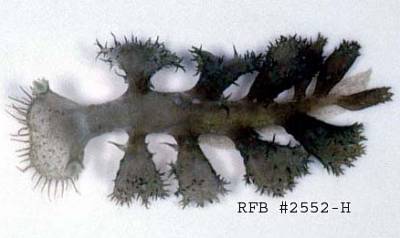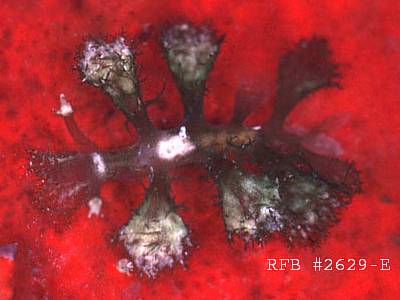

Melibe minuta
Smith & Gosliner, 2003
Order: NUDIBRANCHIA
Suborder: DENDRONOTINA
Family: Tethydidae
DISTRIBUTION
Known only from Okinawa
PHOTO
• RFB #2552-H / TL: 8mm / 3m / Horseshoe Cliffs, Okinawa / 18 May '91
The living animals are a translucent brownish green in color and the largest found was 11mm long. Most are 8mm or shorter. The preserved specimens range in size from 3-10 mm in length and are firm and fleshy. The body is somewhat elongated, and as typical for the genus has an oral hood anteriorly and a series of large flattened cerata attached in a single row along each side. The body surface is mostly smooth, with some wrinkling on the neck, ceratal bases, and the side of the foot. There may also be some low tubercles on the dorsum, and some small raised, opaque, apparently glandular spots on the sides of the body. The oral hood is small, relative to the size of the body, and it has two rows of papillae along the edge. The outer papillae are long and tapering, while the inner papillae are very short, often no more than elongate tubercles. In some specimens one or two extra rows or partial rows of papillae are present. The widely separated rhinophore stalks arise from the 'head' just where the hood joins the body. The rhinophore sheaths are smooth and cylindrical with an out-turned flange which is often ornamented with bead-like projections, or short crenulations with rounded apices. The actual rhinophores are perfoliate with three or four lamellae. There are 4-6 cerata on each side of the dorsum, the anteriormost being opposite in arrangement, but posteriorly they are arranged in an alternating pattern. The base of the cerata forms a cylindrical stalk which flattens out into a fan shaped structure, usually concave on the inner surface. The margins of the cerata bear a combination of multifid projections and papillations, single papillae, crenulations, and tubercles. The inner [dorsal] surface of the cerata can bear some papillae, while the outer [ventral] surface can have low glandular opaque spots or raised tubercles.
Smith & Gosliner noted little sign of autotomy in this species, most of the preserved specimens they studied apparently possessing most of their cerata. The anus is located on a distinctly raised papilla located anterodorsal to the second anterior ceras on the right side. The kidney opening is immediately above the anus. The reproductive opening is anteroventral to the most anterior right ceras.
This species was named from specimens collected by Bob Bolland from a single collection locale at Okinawa [ Horseshoe Cliffs, near Onna Village] over a very short period [May, 1991 ~ July, 1992]. Over that period he collected approximately 237 individuals in 14 separate collections lots.
References:
• Smith, V. G. & Gosliner, T. M. 2003. Systematic review and phylogenetic analysis of the nudibranch genus Melibe (Opisthobranchia: Dendronotacea) with descriptions of three new species. Proceedings of the California Academy of Sciences, 54(18): 302-355, 25 figs.
Rudman, W.B., 2003 (September 15) Melibe minuta Smith & Gosliner, 2003. [In] Sea Slug Forum. Australian Museum, Sydney. Available from http://www.seaslugforum.net/factsheet/meliminu
